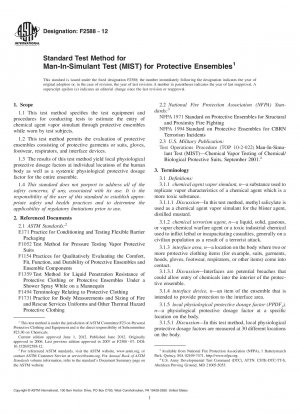ASTM F2588-12
Standard Test Method for Man-In-Simulant Test (MIST) for Protective Ensembles
- Standard No.
- ASTM F2588-12
- Release Date
- 2012
- Published By
- American Society for Testing and Materials (ASTM)
- Status
- Replace By
- ASTM F2588-12(2020)
- Latest
- ASTM F2588-12(2020)
- Scope
This test method is intended to evaluate the penetration and permeation resistance for complete ensembles to vapors from chemical warfare agents and other chemical substances.
This test method differs from Test Method F1052 by providing an evaluation of ensembles worn on human test subjects and measuring the inward leakage of a chemical agent vapor simulant as it would be absorbed by the wearer’s skin. Test Method F1052 is not applicable to the range of protective ensembles that are evaluated by this test method.
This test method differs from Test Method F1359 by using a chemical agent vapor simulant as compared to a liquid challenge and in the use of human test subjects. This test method further provides a quantitative assessment of inward leakage for the chemical agent vapor simulant.
The use of this test method to determine the inward leakage of other chemical vapor threats must be evaluated on a case-by-case basis.
This test method is applied to complete ensembles consisting of a suit or garment in combination with gloves, footwear, respirators, and interface devices.
This test method permits any combination or configuration of ensemble elements and components, including ensembles where the respirator covers the face or head.
This test method accommodates protective ensembles or protective clothing having any combination of the following characteristics:
(1) the protective ensemble or clothing is constructed of air permeable, semipermeable, or impermeable fabrics,
(2) the protective ensemble or clothing is of a single or multi-layered design, or
(3) the protective ensemble or clothing is constructed of inert or sorptive fabrics.
MeS has been used as a simulant for chemical warfare agents. MeS is primarily a simulant for distilled mustard (HD) with a similar vapor pressure, density, and water solubility. The use of MeS in vapor form does not simulate all agents or hazardous substances to which ensemble wearers are potentially exposed.
The principal results of this test are physiological protective dosage factors that indicate the relative effectiveness of the ensemble in preventing the inward leakage of the chemical agent vapor simulant and its consequent dosage to the wearer’s skin as determined by the use and placement of personal adsorbent devices (PAD) on human test subjects.
Specific information on inward leakage of chemical agent vapor simulant is provided by local physiological protective dosage factors for individual PAD locations to assist in determining possible points of entry of the chemical agent vapor simulant into the ensemble.
The determination of the local physiological protective dosage factors is based on ratio of the outside exposure dosage to the inside exposure dosage on the wearer’s skin at specific locations of the body and accounts for the specific susceptibility of the average human’s skin at those locations to the effects of blister agent, distilled mustard using the onset of symptoms exposure dosages (OSED) at different points on the body. The specific OSED values used in this test method are based on the exposure concentration of distilled mustard that cause threshold effects to the average individual human in the form of reversible skin ulceration and blistering (1).
The body locations chosen for the placement of PADs were chosen to represent the range of body areas on the human body, with..........
ASTM F2588-12 Referenced Document
- ASTM E171 Standard Specification for Standard Atmospheres for Conditioning and Testing Flexible Barrier Materials
- ASTM F1052 Standard Test Method for Pressure Testing Vapor Protective Ensembles
- ASTM F1154 Standard Practices for Qualitatively Evaluating the Comfort, Fit, Function, and Integrity of Chemical-Protective Suit Ensembles
- ASTM F1359 Standard Test Method for Liquid Penetration Resistance of Protective Clothing or Protective Ensembles Under a Shower Spray While on a Mannequin
- ASTM F1494 Standard Terminology Relating to Protective Clothing
- ASTM F1731 Standard Practice for Body Measurements and Sizing of Fire and Rescue Services Uniforms and Other Thermal Hazard Protective Clothing
ASTM F2588-12 history
- 2020 ASTM F2588-12(2020) Standard Test Method for Man-In-Simulant Test (MIST) for Protective Ensembles
- 2012 ASTM F2588-12 Standard Test Method for Man-In-Simulant Test (MIST) for Protective Ensembles
- 2007 ASTM F2588-07 Standard Test Method for Man-In-Simulant Test (MIST) for Protective Ensembles
- 2006 ASTM F2588-06 Standard Test Method for Man-In-Simulant Test (MIST) for Protective Ensembles
